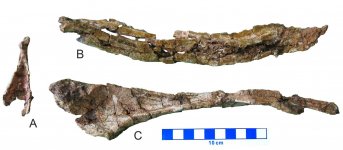Fred Ruhe
Well-known member

Eric Buffetaut, Delphine Angst, Julien Claude, Haiyan Tong, André Amoros, Damien Boschetto, Jean-Pierre Chenet, Didier Clavel, Bruno Maggia, Thomas Roques, Stéphane Sèbe, 2021
Les niveaux à vertébrés fossiles du Crétacé supérieur de Castigno et Combebelle (Villespassans, Hérault): historique et nouvelles découvertes
Carnets natures, 2021, vol. 8 : 33-47
Abstract and free pdf: https://www.researchgate.net/profil...les-decouvertes.pdf?origin=publication_detail
Stratigraphical and palaeontological researches on the continental Upper Cretaceous beds of the Castigno valley (Villespassans, Hérault, southern France) began in the 1890s with the work of the local researcher Jean Miquel. The study of the dinosaur remains from that locality by Charles Depéret in 1900 greatly added to the knowledge of the Late Cretaceous dinosaurs of France. Stratigraphical misinterpretations by Depéret and Miquel then led Emile Haug to believe that the Castigno dinosaurs came from the base of the Tertiary (Montian). This mistake was corrected by Albert F. de Lapparent in 1938. Recent researches at Castigno and at the nearby Combebelle site have yielded remains of various vertebrate groups (amphibians, squamates, turtles, crocodiles, dinosaurs, birds) from several fossil-bearing horizons, corresponding to different depositional environments (fluvial followed by lacustrine), probably referrable to the upper Campanian. The Castigno-Combebelle sedimentary series is clearly important for our understanding of vertebrate faunal succession in the Late Cretaceous of Languedoc
The paper is in French. This is the part on birds (quotation):
Oiseaux (Fig. 1):
Enantiornithes: représentés par un coracoïde de grande taille trouvé en 2019, indiquant un nouveau taxon.
Gargantuaviidae: deux scapulas de très grande taille, appartenant très probablement au même individu, trouvées en 2020, appartiennent à un oiseau géant, attribuable vraisemblablement à la famille des Gargantuaviidae. Cette famille est représentée à Montplo-Nord (Cruzy) par divers ossements attribués à Gargantuavis philoinos et à Combebelle par un fémur incomplet de grande taille (voir plus bas).
Enjoy,
Fred
Fig. 1 – Restes d’oiseaux provenant des couches argilo-gréseuses rouges à Castigno. A : coracoïde droit d’enantiornithe, vue dorsale – Musée de Cruzy, VC-Z2-6 ; B, C : scapulas de Gargantuaviidae (B : scapula droite en vue dorsale – Musée de Cruzy, VC-Z2-12 ; C : scapula gauche en vue latérale – Musée de Cruzy, VC-Z2-11). Photo E. Buffetaut
Les niveaux à vertébrés fossiles du Crétacé supérieur de Castigno et Combebelle (Villespassans, Hérault): historique et nouvelles découvertes
Carnets natures, 2021, vol. 8 : 33-47
Abstract and free pdf: https://www.researchgate.net/profil...les-decouvertes.pdf?origin=publication_detail
Stratigraphical and palaeontological researches on the continental Upper Cretaceous beds of the Castigno valley (Villespassans, Hérault, southern France) began in the 1890s with the work of the local researcher Jean Miquel. The study of the dinosaur remains from that locality by Charles Depéret in 1900 greatly added to the knowledge of the Late Cretaceous dinosaurs of France. Stratigraphical misinterpretations by Depéret and Miquel then led Emile Haug to believe that the Castigno dinosaurs came from the base of the Tertiary (Montian). This mistake was corrected by Albert F. de Lapparent in 1938. Recent researches at Castigno and at the nearby Combebelle site have yielded remains of various vertebrate groups (amphibians, squamates, turtles, crocodiles, dinosaurs, birds) from several fossil-bearing horizons, corresponding to different depositional environments (fluvial followed by lacustrine), probably referrable to the upper Campanian. The Castigno-Combebelle sedimentary series is clearly important for our understanding of vertebrate faunal succession in the Late Cretaceous of Languedoc
The paper is in French. This is the part on birds (quotation):
Oiseaux (Fig. 1):
Enantiornithes: représentés par un coracoïde de grande taille trouvé en 2019, indiquant un nouveau taxon.
Gargantuaviidae: deux scapulas de très grande taille, appartenant très probablement au même individu, trouvées en 2020, appartiennent à un oiseau géant, attribuable vraisemblablement à la famille des Gargantuaviidae. Cette famille est représentée à Montplo-Nord (Cruzy) par divers ossements attribués à Gargantuavis philoinos et à Combebelle par un fémur incomplet de grande taille (voir plus bas).
Enjoy,
Fred
Fig. 1 – Restes d’oiseaux provenant des couches argilo-gréseuses rouges à Castigno. A : coracoïde droit d’enantiornithe, vue dorsale – Musée de Cruzy, VC-Z2-6 ; B, C : scapulas de Gargantuaviidae (B : scapula droite en vue dorsale – Musée de Cruzy, VC-Z2-12 ; C : scapula gauche en vue latérale – Musée de Cruzy, VC-Z2-11). Photo E. Buffetaut




